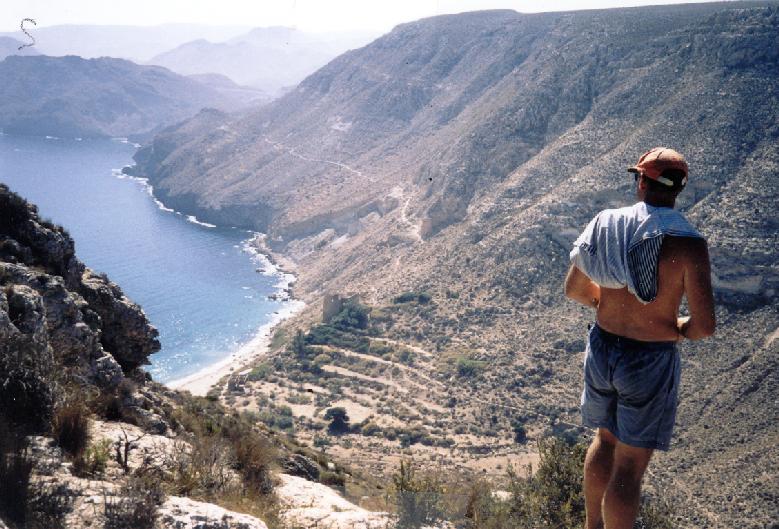
After a 4-km walk along a trail along the coast under a hot summer sun, we entered a pleasant, tree covered area. A young Spanish girl darkly tanned and naked, was talking to someone at a water spring, undisturbed by the sudden appearance of hikers. We filled our water bottles and left.
Las Negras is a small village on the coast of South-East Spain, in the dry area of the Cabo de Gata (Cape of the Cats). Most of this area is a National Park. Almeria is the biggest nearby town. This area still has escaped mass tourism unlike the other coastal areas. It is a true dessert with numerous cactus trees with juicy fruits. These were once imported from Mexico but now they slowly cover the hills pushing out other indigenous shrubs.
In the late eighties a Swiss developer acquired large pieces of land around Las Negras and only a few years later he got permission to build luxurious summer cottages on the hillside. Now the white cottages dot the hillside. The village is still small and the beaches relatively quiet.
The hills surrounding the village are well suited for hill walking but very few tourists do it and herdsmen mostly use the trails.
A gravel road starts North of the village of Las Negras and for two kilometers winds through the mountains. At the steep coast the road suddenly ends and a small trail, partly washed out, leads to San Pedro.
Crossing the last ridge we have a wide view over the valley of San Pedro with around ten scattered houses and many olive trees. The village was deserted some 20 years ago and most of the houses have no windows or doors.
The first building we passed was a water mill that used water from a natural well for power. This area is densely grown with plants and trees and you can smell the moist air. Ruud who had been here before said that we could drink the cool water and fill up the water bottles. On entering we heard a Spanish female voice mixed with the sound of running water.
A Spanish girl and boy in their twenties were sitting at the edge of small concrete water basin. They were both darkly tanned with dirty, entangled long hair and fully naked. They ignored us and kept on talking. After walking for an hour in the midday heat, we were overwhelmed by their innocent nakedness.
We drank the cool water and filled our water bottles. After a last look at the two we carried on. Ruud explained that the people now occupying the village were underground types and some he suspected were drug addicts so he told us to watch our stuff.
Walking towards the beach, we saw a few persons in some of the squatted houses that looked run down, basically having 4 walls but with no doors and windows. Some also stayed in tents. In total there were perhaps 30 - 40 persons. The olive and fruit trees still looked in good shape, lining the lower part of the valley. Ruud took a swim but I thought the salty water would get you thirsty and warm and we still had a long walk that day.
The coastal trail was the only trail out as the valley inland was surrounded by steep rock walls of some 200 m. We followed the steep trail South and after an hour arrived at the next hamlet on a wide, nearly deserted beach.
We went swimming in the warm water and sat down in the sun. A Spanish couple in their late forties, a bit overweight, passed us, waded along the seashore around big boulders and disappeared. Surprised by the route they took, I followed them, as this was a dead end. They simply found a private spot to be naked and were splashing in the water like young children.
Ruud took us to his farm 4 km inland. He bought the 20 hectares of land a few years ago. The farmhouse was in poor shape. Walls were made of rock boulders kept together by cement but these were crumbling. After chasing out the goats that lived inside the farmhouse for several years, and scooping out layers of hard goat shit, he tried to build a kitchen and a bathroom but the walls and roof collapsed during the reconstruction. His only option was to level the place and build a new house.
The farm had a nearby well but the water tasted of salt and gypsum and this time I passed remembering the bad taste from a few weeks ago when we camped here. Ruud said there was an 8-km goat trail through the hills back to Las Negras but the trail was little used. The trail was traceable although the thick shrubs and nettles sometimes gave us a hard time. Now the valley that was surprisingly green as no herds of cattle grazed in this area. Herding goat and sheep is not as common any more and nature reacts quickly. The trail already badly visible and another few years it would be fully overgrown. Past a pass and close to Las Negras the trail was used again by a few farms and ran along a riverbed with dense vegetation. The entire trip took us a full 10 hours, roughly 20 km walking, arriving past 8 PM in the village.
You wonder how large the effect would be on banning goats and sheep on the natural vegetation, which in turns influences the climate because of land use. Barren lands are 3-5 degrees Celsius warmer than heavily grown areas in the summer. How much land, now desert, was turned into barren land by land use, by herds of cattle, especially goats that can eat anything. The Sahara used to be a savanna area with herds of wild animals until 3000 BC. At the same time there was a human expansion with similar amounts of cattle starting in 8000 BC.